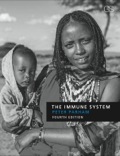
Concept explainers
(a)
To write:
The name of the primary lymphoid tissues in mammals and the main types of secondary lymphoid tissue.
Introduction:
Lymphoid tissues can be defined as organized structures that are a vital part of the immune system. It protects the body from infections and potential pathogens. Some of the important lymphoid tissues are spleen, bone marrow and thymus.
Explanation of Solution
The lymphoid tissues are divided into two types according to their functions. They are primary and secondary lymphoid tissues. Primary lymphoid tissues include bone marrow and thymus. Apart from them, every other type of lymphoid tissue is known as secondary lymphoid tissue. The main secondary lymphoid tissues include the spleen, mucosa-associated lymphoid tissues (MALT) and lymph nodes. These also include gut-associated lymphoid tissue (GALT), such as the adenoids, tonsils, Peyer's patches, appendix and bronchial-associated lymphoid tissues (BALT).
Therefore, primary lymphoid tissues are bone marrow and thymus and the main secondary lymphoid tissues include the spleen, mucosa-associated lymphoid tissues (MALT) and lymph nodes.
(b)
To write:
The differences in functions of primary and secondary lymphoid tissues and discuss the principal events that take place in each.
Introduction:
Lymphoid tissues can be defined as organized structures that are a vital part of the immune system. It protects the body from infections and potential pathogens. Some of the important lymphoid tissues are spleen, bone marrow and thymus.
Explanation of Solution
Central or primary lymphoid tissues are the anatomical locations where lymphocytes get developed and reach the state of maturation required where they can respond to a potential pathogen. B cells are matured in the bone marrow and fetal liver before entering the circulation, whereas T cells mature leave the bone marrow at the immature stage and mature in the thymus. Both lymphocyte lineages are derived from a common hematopoietic stem cell.
Secondary lymphoid tissues are the anatomical locations where lymphocytes encounter antigen and immune responses get induced. Antigen is delivered to the secondary lymphoid tissues through an afferent lymphatic vessel. It is reserved in the lymphoid tissue to encounter with lymphocytes having antigen specific receptors.
Therefore, primary lymphoid tissues are the anatomical locations where lymphocytes get developed and reach the state of maturation required where they can respond to a potential pathogen. Whereas, secondary lymphoid tissues are the anatomical locations where lymphocytes encounter antigen and immune responses get induced.
Want to see more full solutions like this?
- What is the result of the following gram stain: positive ○ capsulated ○ acid-fast ○ negativearrow_forwardWhat type of stain is the image below: capsule stain endospore stain gram stain negative stain ASM MicrobeLibrary.org Keplingerarrow_forwardWhat is the result of the acid-fast stain below: Stock Images by Getty Images by Getty Images by Getty Images by Getty Image Getty Images St Soy Getty Images by Getty Images by Getty Images Joy Getty encapsulated O endosporulating negative ○ positivearrow_forward
- You have a stock vial of diligence 75mg in 3ml and need to draw up a dose of 50mg for your patient.how many mls should you draw up to give this dosearrow_forwardYou are recquired to administer 150mg hydrocortisone intravenously,how many mls should you give?(stock =hydrocortisone 100mg in 2mls)arrow_forwardIf someone was working with a 50 MBq F-18 source, what would be the internal and external dose consequences?arrow_forward
- We will be starting a group project next week where you and your group will research and ultimately present on a current research article related to the biology of a pathogen that infects humans. The article could be about the pathogen itself, the disease process related to the pathogen, the immune response to the pathogen, vaccines or treatments that affect the pathogen, or other biology-related study about the pathogen. I recommend that you choose a pathogen that is currently interesting to researchers, so that you will be able to find plenty of articles about it. Avoid choosing a historical disease that no longer circulates. List 3 possible pathogens or diseases that you might want to do for your group project.arrow_forwardnot use ai pleasearrow_forwardDNK dagi nukleotidlar va undan sintezlangan oqsildagi peptid boglar farqi 901 taga teng bo'lib undagi A jami H boglardan 6,5 marta kam bo'lsa DNK dagi jami H bog‘lar sonini topingarrow_forward
- One of the ways for a cell to generate ATP is through the oxidative phosphorylation. In oxidative phosphorylation 3 ATP are produced from every one NADH molecule. In respiration, every glucose molecule produces 10 NADH molecules. If a cell is growing on 5 glucose molecules, how much ATP can be produced using oxidative phosphorylation/aerobic respiration?arrow_forwardIf a cell is growing on 5 glucose molecules, how much ATP can be produced using oxidative phosphorylation/aerobic respiration?arrow_forwardHow do i know which way the arrows go?arrow_forward
 Human Anatomy & Physiology (11th Edition)BiologyISBN:9780134580999Author:Elaine N. Marieb, Katja N. HoehnPublisher:PEARSON
Human Anatomy & Physiology (11th Edition)BiologyISBN:9780134580999Author:Elaine N. Marieb, Katja N. HoehnPublisher:PEARSON Biology 2eBiologyISBN:9781947172517Author:Matthew Douglas, Jung Choi, Mary Ann ClarkPublisher:OpenStax
Biology 2eBiologyISBN:9781947172517Author:Matthew Douglas, Jung Choi, Mary Ann ClarkPublisher:OpenStax Anatomy & PhysiologyBiologyISBN:9781259398629Author:McKinley, Michael P., O'loughlin, Valerie Dean, Bidle, Theresa StouterPublisher:Mcgraw Hill Education,
Anatomy & PhysiologyBiologyISBN:9781259398629Author:McKinley, Michael P., O'loughlin, Valerie Dean, Bidle, Theresa StouterPublisher:Mcgraw Hill Education, Molecular Biology of the Cell (Sixth Edition)BiologyISBN:9780815344322Author:Bruce Alberts, Alexander D. Johnson, Julian Lewis, David Morgan, Martin Raff, Keith Roberts, Peter WalterPublisher:W. W. Norton & Company
Molecular Biology of the Cell (Sixth Edition)BiologyISBN:9780815344322Author:Bruce Alberts, Alexander D. Johnson, Julian Lewis, David Morgan, Martin Raff, Keith Roberts, Peter WalterPublisher:W. W. Norton & Company Laboratory Manual For Human Anatomy & PhysiologyBiologyISBN:9781260159363Author:Martin, Terry R., Prentice-craver, CynthiaPublisher:McGraw-Hill Publishing Co.
Laboratory Manual For Human Anatomy & PhysiologyBiologyISBN:9781260159363Author:Martin, Terry R., Prentice-craver, CynthiaPublisher:McGraw-Hill Publishing Co. Inquiry Into Life (16th Edition)BiologyISBN:9781260231700Author:Sylvia S. Mader, Michael WindelspechtPublisher:McGraw Hill Education
Inquiry Into Life (16th Edition)BiologyISBN:9781260231700Author:Sylvia S. Mader, Michael WindelspechtPublisher:McGraw Hill Education





